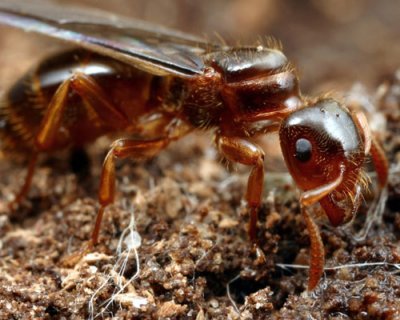Mechanism
What allows them to do this?
|
Polyergus breviceps has specialized in
raiding other colonies to such an extent that their mandibles are no
longer suitable for the normal activities of a worker. They are
specially designed to pierce the exoskeleton of another ant (3. Slave
Raiding Ant) Even when placed in proximity to a food source, a Polyergus
worker will starve to death without a slave to feed it (2. Wilson, E.
O. 1975). Specializing to such a degree has allowed Polyergus
to become brutally efficient at conducting raids and cutting through
defenders, but unable to dig a nest and care for its young.
|

|
Formica subintcgra and Formica pcrgandei have a different
tactic. They produce "remarkably large quantities of decyl,
dodecyl and tetradecyl acetates." (2. Wilson, E. O., 1975).
Normally, these are used as alarm pheromones. A worker who receives
it will go into a panicked nest defense mode. However, both of these
Formica enslaver species take advantage of the fact that if a worker is
exposed to a large enough concentration of these chemicals, she will
become confused and erratic. Whenever the enslavers encounter
resistance from a colony, they spray these pheromones on the opposing
group. It both attracts more of the enslaver ants and throws the
defenders into disarray.

|
The other form of slave making ants is not through nest raids and larvae
thievery, but through usurping the old queen. A Lasius claviger queen, for example,
will attempt to gain entry to a target colony through evading or
sedating any workers she encounters, and then assassinates the
resident queen (4. Social Parasitism in Ants). The Polyergus
breviceps queen enters the host nest and is attacked by their workers. The instant she engages
the host queen, the host workers stop attacking her. After she assassinates the queen, the P.
breviceps queen rubs her body on the dead queen's body to pick up her scent before continuing on
to conduct the colony (18. Johnson, A. 2001)
|
|

